Business and the Business Environment: HSBC Report - Semester 1
VerifiedAdded on 2023/01/12
|17
|5002
|23
Report
AI Summary
This report provides a comprehensive analysis of the business environment, using HSBC Holdings plc as a case study. It begins by defining the business environment and its internal and external factors, followed by an examination of different organizational types (private, public, and voluntary sectors), their purposes, and legal structures. The report then delves into the size and scope of these organizations, using examples like National Health Services and Oxfam for comparison. It explores the interrelation between distinct organizational functions (HRM, Marketing, Finance, Operations) and how they link to the firm's objectives and structure. The report further identifies the positive and negative impacts of the macro environment on business operations, supported by specific examples. Finally, it conducts internal and external analyses of HSBC to identify its strengths and weaknesses, explaining how these interrelate with external macro factors, concluding with a summary of the overall findings.
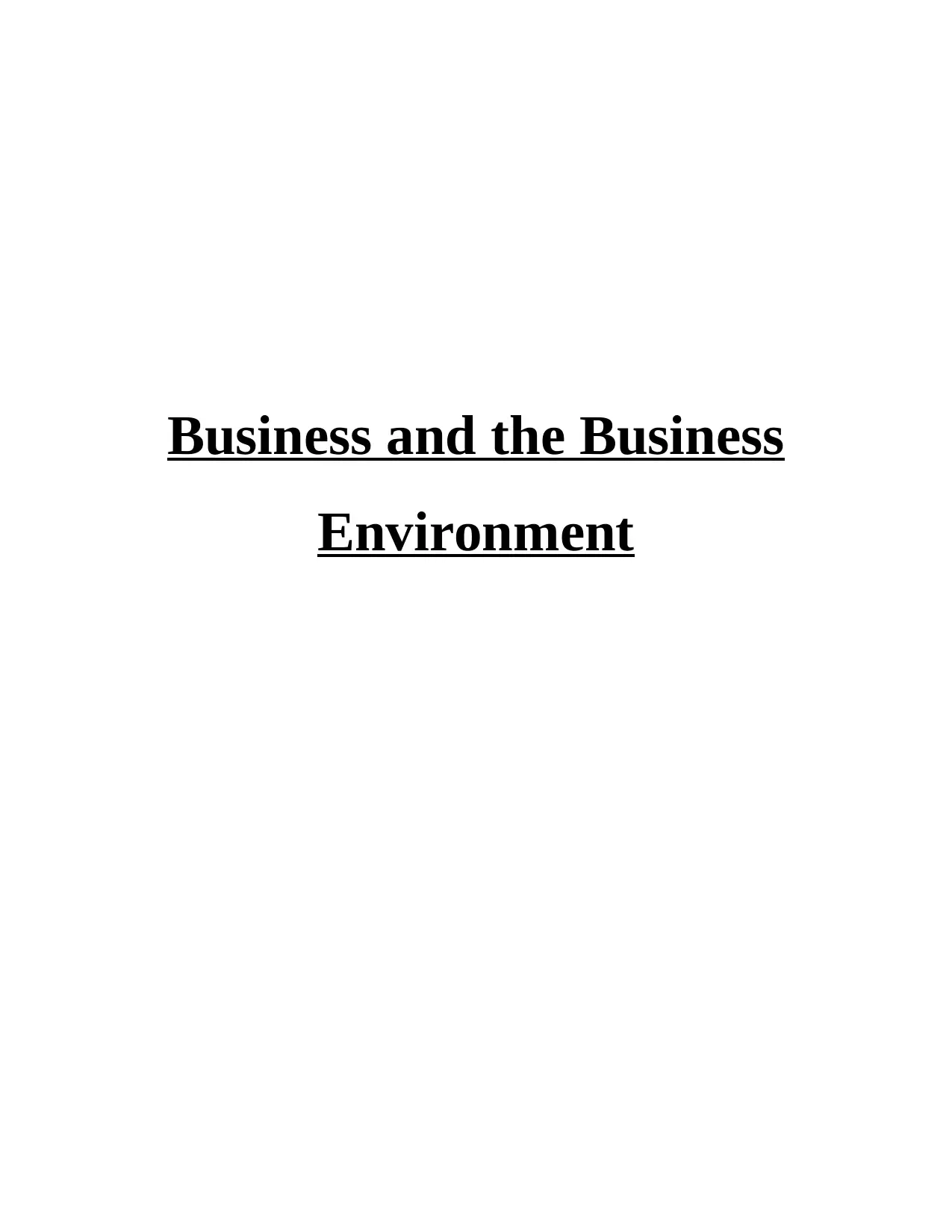
Business and the Business
Environment
Environment
Paraphrase This Document
Need a fresh take? Get an instant paraphrase of this document with our AI Paraphraser
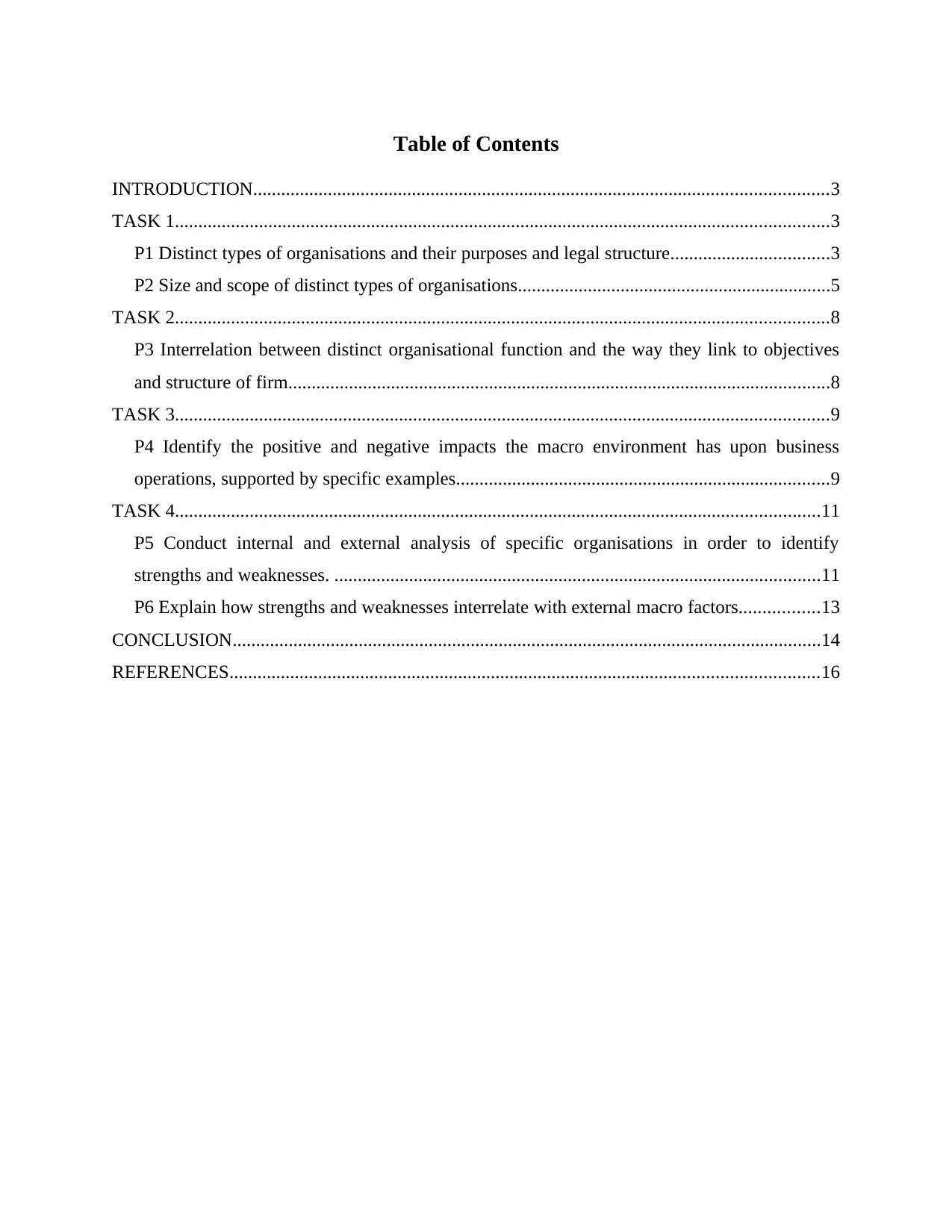
Table of Contents
INTRODUCTION...........................................................................................................................3
TASK 1............................................................................................................................................3
P1 Distinct types of organisations and their purposes and legal structure..................................3
P2 Size and scope of distinct types of organisations...................................................................5
TASK 2............................................................................................................................................8
P3 Interrelation between distinct organisational function and the way they link to objectives
and structure of firm....................................................................................................................8
TASK 3............................................................................................................................................9
P4 Identify the positive and negative impacts the macro environment has upon business
operations, supported by specific examples................................................................................9
TASK 4..........................................................................................................................................11
P5 Conduct internal and external analysis of specific organisations in order to identify
strengths and weaknesses. ........................................................................................................11
P6 Explain how strengths and weaknesses interrelate with external macro factors.................13
CONCLUSION..............................................................................................................................14
REFERENCES..............................................................................................................................16
INTRODUCTION...........................................................................................................................3
TASK 1............................................................................................................................................3
P1 Distinct types of organisations and their purposes and legal structure..................................3
P2 Size and scope of distinct types of organisations...................................................................5
TASK 2............................................................................................................................................8
P3 Interrelation between distinct organisational function and the way they link to objectives
and structure of firm....................................................................................................................8
TASK 3............................................................................................................................................9
P4 Identify the positive and negative impacts the macro environment has upon business
operations, supported by specific examples................................................................................9
TASK 4..........................................................................................................................................11
P5 Conduct internal and external analysis of specific organisations in order to identify
strengths and weaknesses. ........................................................................................................11
P6 Explain how strengths and weaknesses interrelate with external macro factors.................13
CONCLUSION..............................................................................................................................14
REFERENCES..............................................................................................................................16
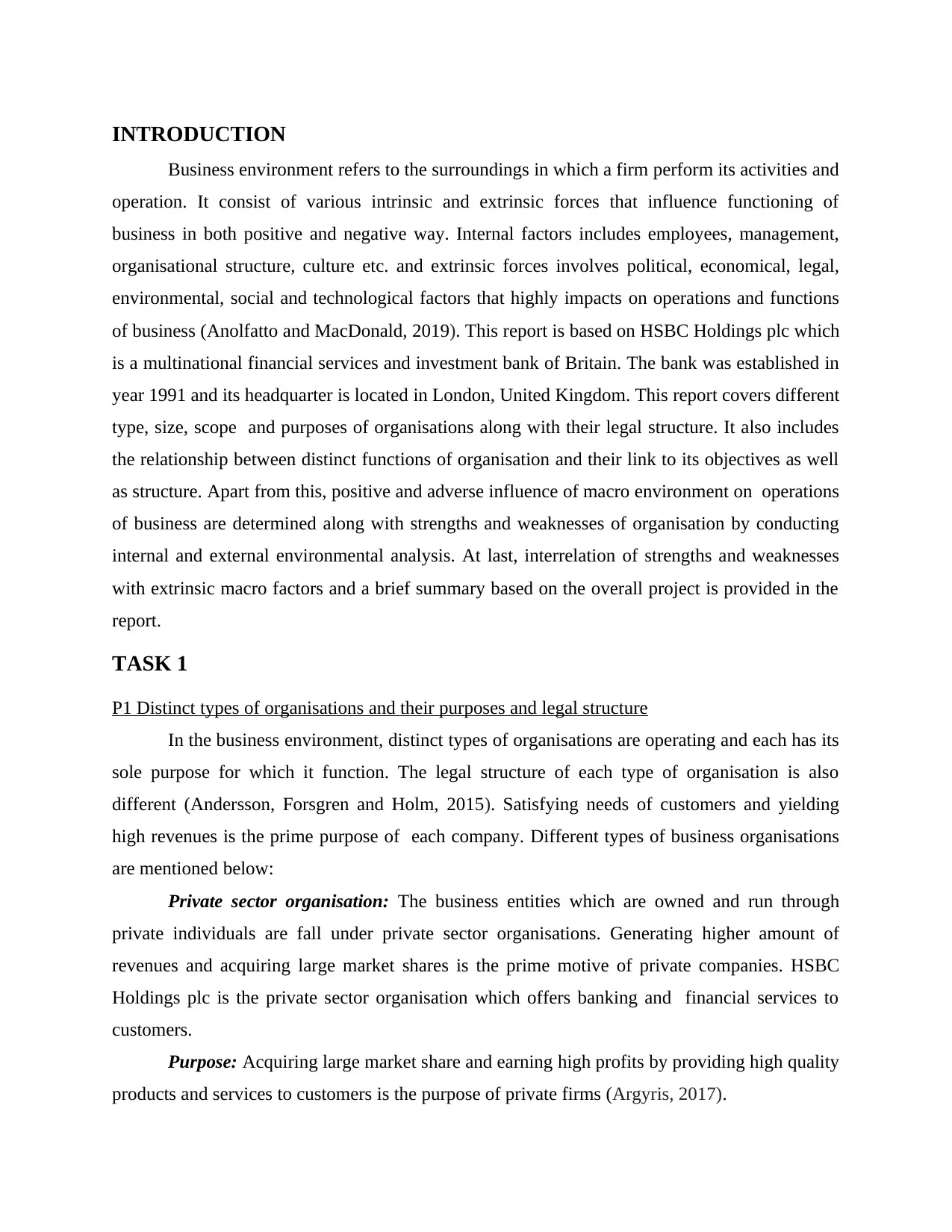
INTRODUCTION
Business environment refers to the surroundings in which a firm perform its activities and
operation. It consist of various intrinsic and extrinsic forces that influence functioning of
business in both positive and negative way. Internal factors includes employees, management,
organisational structure, culture etc. and extrinsic forces involves political, economical, legal,
environmental, social and technological factors that highly impacts on operations and functions
of business (Anolfatto and MacDonald, 2019). This report is based on HSBC Holdings plc which
is a multinational financial services and investment bank of Britain. The bank was established in
year 1991 and its headquarter is located in London, United Kingdom. This report covers different
type, size, scope and purposes of organisations along with their legal structure. It also includes
the relationship between distinct functions of organisation and their link to its objectives as well
as structure. Apart from this, positive and adverse influence of macro environment on operations
of business are determined along with strengths and weaknesses of organisation by conducting
internal and external environmental analysis. At last, interrelation of strengths and weaknesses
with extrinsic macro factors and a brief summary based on the overall project is provided in the
report.
TASK 1
P1 Distinct types of organisations and their purposes and legal structure
In the business environment, distinct types of organisations are operating and each has its
sole purpose for which it function. The legal structure of each type of organisation is also
different (Andersson, Forsgren and Holm, 2015). Satisfying needs of customers and yielding
high revenues is the prime purpose of each company. Different types of business organisations
are mentioned below:
Private sector organisation: The business entities which are owned and run through
private individuals are fall under private sector organisations. Generating higher amount of
revenues and acquiring large market shares is the prime motive of private companies. HSBC
Holdings plc is the private sector organisation which offers banking and financial services to
customers.
Purpose: Acquiring large market share and earning high profits by providing high quality
products and services to customers is the purpose of private firms (Argyris, 2017).
Business environment refers to the surroundings in which a firm perform its activities and
operation. It consist of various intrinsic and extrinsic forces that influence functioning of
business in both positive and negative way. Internal factors includes employees, management,
organisational structure, culture etc. and extrinsic forces involves political, economical, legal,
environmental, social and technological factors that highly impacts on operations and functions
of business (Anolfatto and MacDonald, 2019). This report is based on HSBC Holdings plc which
is a multinational financial services and investment bank of Britain. The bank was established in
year 1991 and its headquarter is located in London, United Kingdom. This report covers different
type, size, scope and purposes of organisations along with their legal structure. It also includes
the relationship between distinct functions of organisation and their link to its objectives as well
as structure. Apart from this, positive and adverse influence of macro environment on operations
of business are determined along with strengths and weaknesses of organisation by conducting
internal and external environmental analysis. At last, interrelation of strengths and weaknesses
with extrinsic macro factors and a brief summary based on the overall project is provided in the
report.
TASK 1
P1 Distinct types of organisations and their purposes and legal structure
In the business environment, distinct types of organisations are operating and each has its
sole purpose for which it function. The legal structure of each type of organisation is also
different (Andersson, Forsgren and Holm, 2015). Satisfying needs of customers and yielding
high revenues is the prime purpose of each company. Different types of business organisations
are mentioned below:
Private sector organisation: The business entities which are owned and run through
private individuals are fall under private sector organisations. Generating higher amount of
revenues and acquiring large market shares is the prime motive of private companies. HSBC
Holdings plc is the private sector organisation which offers banking and financial services to
customers.
Purpose: Acquiring large market share and earning high profits by providing high quality
products and services to customers is the purpose of private firms (Argyris, 2017).
⊘ This is a preview!⊘
Do you want full access?
Subscribe today to unlock all pages.

Trusted by 1+ million students worldwide
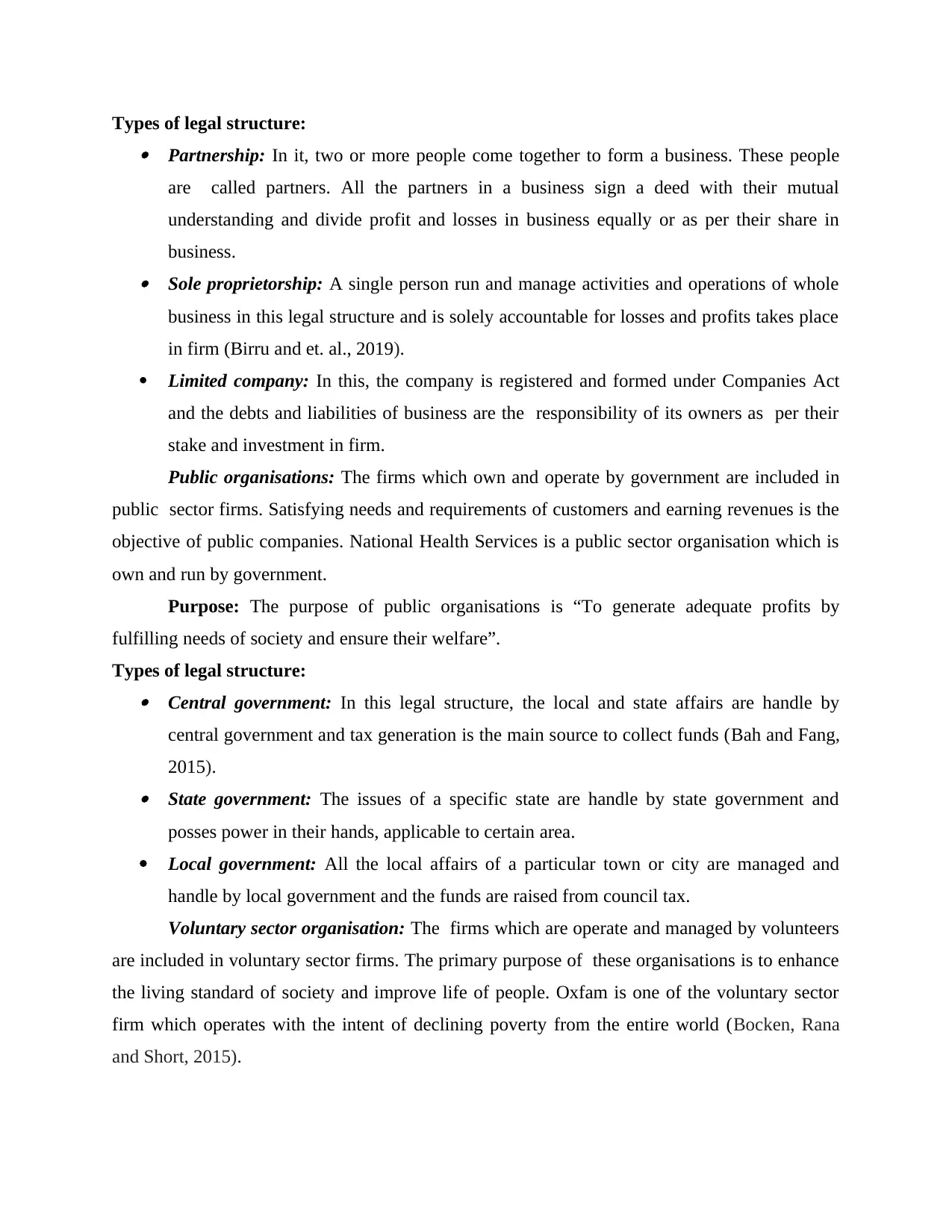
Types of legal structure: Partnership: In it, two or more people come together to form a business. These people
are called partners. All the partners in a business sign a deed with their mutual
understanding and divide profit and losses in business equally or as per their share in
business. Sole proprietorship: A single person run and manage activities and operations of whole
business in this legal structure and is solely accountable for losses and profits takes place
in firm (Birru and et. al., 2019).
Limited company: In this, the company is registered and formed under Companies Act
and the debts and liabilities of business are the responsibility of its owners as per their
stake and investment in firm.
Public organisations: The firms which own and operate by government are included in
public sector firms. Satisfying needs and requirements of customers and earning revenues is the
objective of public companies. National Health Services is a public sector organisation which is
own and run by government.
Purpose: The purpose of public organisations is “To generate adequate profits by
fulfilling needs of society and ensure their welfare”.
Types of legal structure: Central government: In this legal structure, the local and state affairs are handle by
central government and tax generation is the main source to collect funds (Bah and Fang,
2015). State government: The issues of a specific state are handle by state government and
posses power in their hands, applicable to certain area.
Local government: All the local affairs of a particular town or city are managed and
handle by local government and the funds are raised from council tax.
Voluntary sector organisation: The firms which are operate and managed by volunteers
are included in voluntary sector firms. The primary purpose of these organisations is to enhance
the living standard of society and improve life of people. Oxfam is one of the voluntary sector
firm which operates with the intent of declining poverty from the entire world (Bocken, Rana
and Short, 2015).
are called partners. All the partners in a business sign a deed with their mutual
understanding and divide profit and losses in business equally or as per their share in
business. Sole proprietorship: A single person run and manage activities and operations of whole
business in this legal structure and is solely accountable for losses and profits takes place
in firm (Birru and et. al., 2019).
Limited company: In this, the company is registered and formed under Companies Act
and the debts and liabilities of business are the responsibility of its owners as per their
stake and investment in firm.
Public organisations: The firms which own and operate by government are included in
public sector firms. Satisfying needs and requirements of customers and earning revenues is the
objective of public companies. National Health Services is a public sector organisation which is
own and run by government.
Purpose: The purpose of public organisations is “To generate adequate profits by
fulfilling needs of society and ensure their welfare”.
Types of legal structure: Central government: In this legal structure, the local and state affairs are handle by
central government and tax generation is the main source to collect funds (Bah and Fang,
2015). State government: The issues of a specific state are handle by state government and
posses power in their hands, applicable to certain area.
Local government: All the local affairs of a particular town or city are managed and
handle by local government and the funds are raised from council tax.
Voluntary sector organisation: The firms which are operate and managed by volunteers
are included in voluntary sector firms. The primary purpose of these organisations is to enhance
the living standard of society and improve life of people. Oxfam is one of the voluntary sector
firm which operates with the intent of declining poverty from the entire world (Bocken, Rana
and Short, 2015).
Paraphrase This Document
Need a fresh take? Get an instant paraphrase of this document with our AI Paraphraser
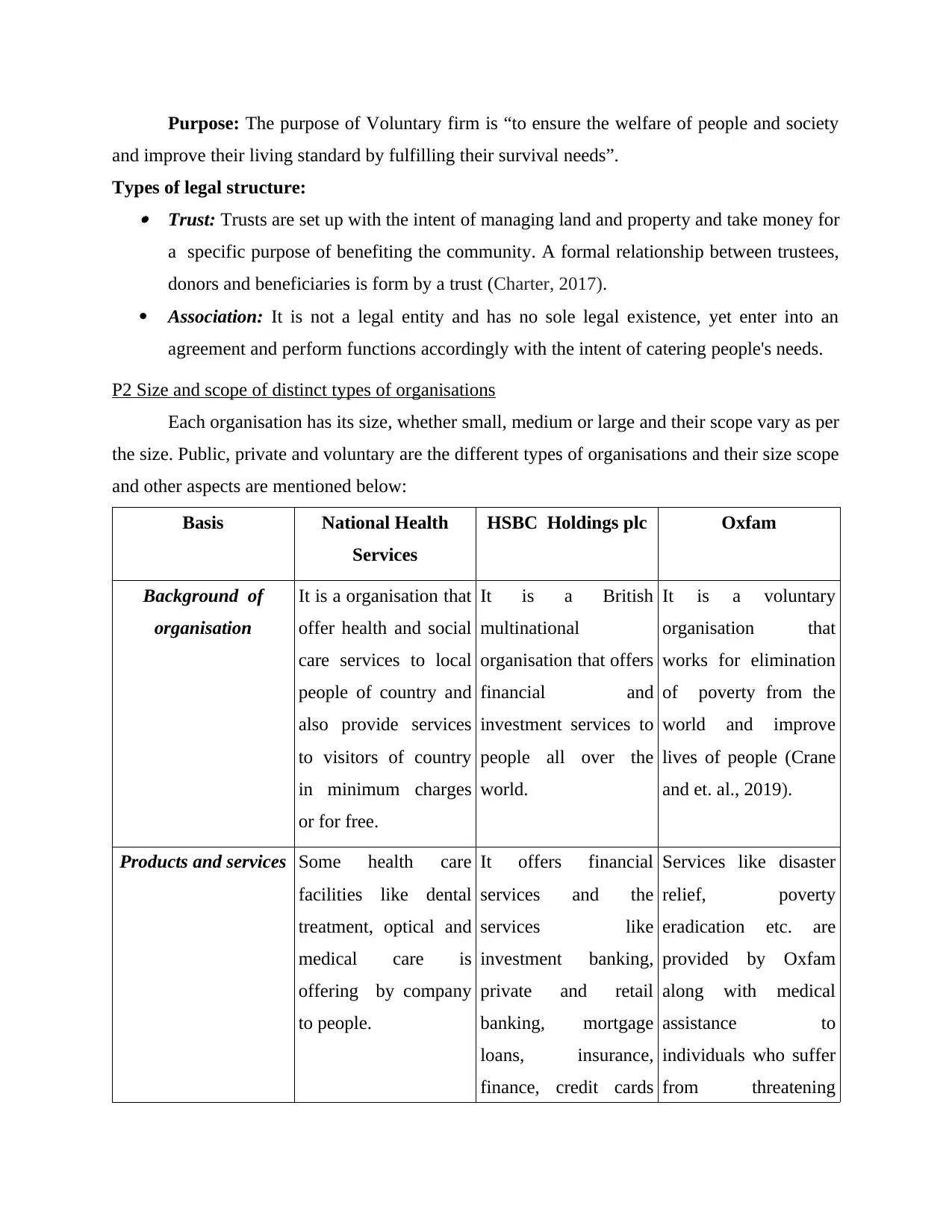
Purpose: The purpose of Voluntary firm is “to ensure the welfare of people and society
and improve their living standard by fulfilling their survival needs”.
Types of legal structure: Trust: Trusts are set up with the intent of managing land and property and take money for
a specific purpose of benefiting the community. A formal relationship between trustees,
donors and beneficiaries is form by a trust (Charter, 2017).
Association: It is not a legal entity and has no sole legal existence, yet enter into an
agreement and perform functions accordingly with the intent of catering people's needs.
P2 Size and scope of distinct types of organisations
Each organisation has its size, whether small, medium or large and their scope vary as per
the size. Public, private and voluntary are the different types of organisations and their size scope
and other aspects are mentioned below:
Basis National Health
Services
HSBC Holdings plc Oxfam
Background of
organisation
It is a organisation that
offer health and social
care services to local
people of country and
also provide services
to visitors of country
in minimum charges
or for free.
It is a British
multinational
organisation that offers
financial and
investment services to
people all over the
world.
It is a voluntary
organisation that
works for elimination
of poverty from the
world and improve
lives of people (Crane
and et. al., 2019).
Products and services Some health care
facilities like dental
treatment, optical and
medical care is
offering by company
to people.
It offers financial
services and the
services like
investment banking,
private and retail
banking, mortgage
loans, insurance,
finance, credit cards
Services like disaster
relief, poverty
eradication etc. are
provided by Oxfam
along with medical
assistance to
individuals who suffer
from threatening
and improve their living standard by fulfilling their survival needs”.
Types of legal structure: Trust: Trusts are set up with the intent of managing land and property and take money for
a specific purpose of benefiting the community. A formal relationship between trustees,
donors and beneficiaries is form by a trust (Charter, 2017).
Association: It is not a legal entity and has no sole legal existence, yet enter into an
agreement and perform functions accordingly with the intent of catering people's needs.
P2 Size and scope of distinct types of organisations
Each organisation has its size, whether small, medium or large and their scope vary as per
the size. Public, private and voluntary are the different types of organisations and their size scope
and other aspects are mentioned below:
Basis National Health
Services
HSBC Holdings plc Oxfam
Background of
organisation
It is a organisation that
offer health and social
care services to local
people of country and
also provide services
to visitors of country
in minimum charges
or for free.
It is a British
multinational
organisation that offers
financial and
investment services to
people all over the
world.
It is a voluntary
organisation that
works for elimination
of poverty from the
world and improve
lives of people (Crane
and et. al., 2019).
Products and services Some health care
facilities like dental
treatment, optical and
medical care is
offering by company
to people.
It offers financial
services and the
services like
investment banking,
private and retail
banking, mortgage
loans, insurance,
finance, credit cards
Services like disaster
relief, poverty
eradication etc. are
provided by Oxfam
along with medical
assistance to
individuals who suffer
from threatening
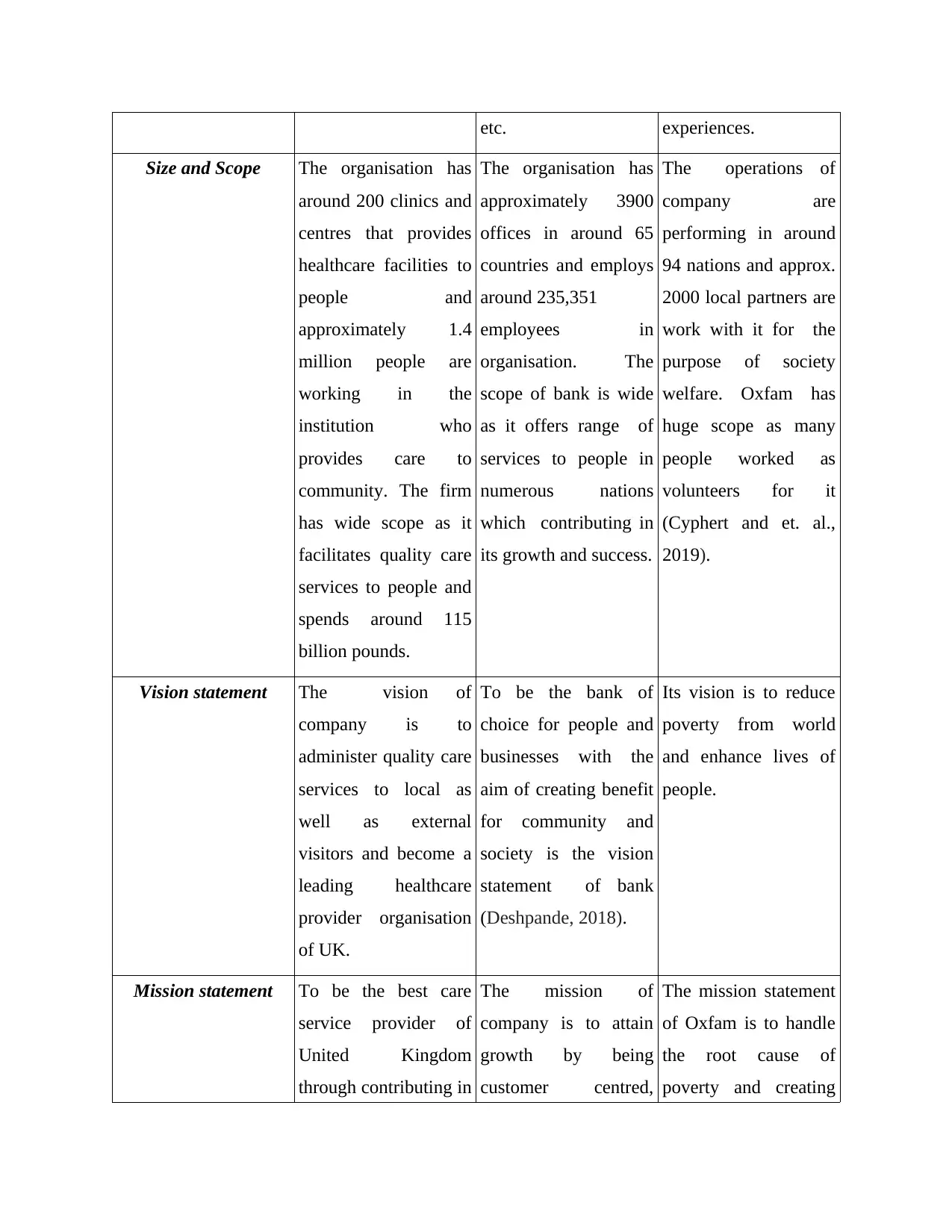
etc. experiences.
Size and Scope The organisation has
around 200 clinics and
centres that provides
healthcare facilities to
people and
approximately 1.4
million people are
working in the
institution who
provides care to
community. The firm
has wide scope as it
facilitates quality care
services to people and
spends around 115
billion pounds.
The organisation has
approximately 3900
offices in around 65
countries and employs
around 235,351
employees in
organisation. The
scope of bank is wide
as it offers range of
services to people in
numerous nations
which contributing in
its growth and success.
The operations of
company are
performing in around
94 nations and approx.
2000 local partners are
work with it for the
purpose of society
welfare. Oxfam has
huge scope as many
people worked as
volunteers for it
(Cyphert and et. al.,
2019).
Vision statement The vision of
company is to
administer quality care
services to local as
well as external
visitors and become a
leading healthcare
provider organisation
of UK.
To be the bank of
choice for people and
businesses with the
aim of creating benefit
for community and
society is the vision
statement of bank
(Deshpande, 2018).
Its vision is to reduce
poverty from world
and enhance lives of
people.
Mission statement To be the best care
service provider of
United Kingdom
through contributing in
The mission of
company is to attain
growth by being
customer centred,
The mission statement
of Oxfam is to handle
the root cause of
poverty and creating
Size and Scope The organisation has
around 200 clinics and
centres that provides
healthcare facilities to
people and
approximately 1.4
million people are
working in the
institution who
provides care to
community. The firm
has wide scope as it
facilitates quality care
services to people and
spends around 115
billion pounds.
The organisation has
approximately 3900
offices in around 65
countries and employs
around 235,351
employees in
organisation. The
scope of bank is wide
as it offers range of
services to people in
numerous nations
which contributing in
its growth and success.
The operations of
company are
performing in around
94 nations and approx.
2000 local partners are
work with it for the
purpose of society
welfare. Oxfam has
huge scope as many
people worked as
volunteers for it
(Cyphert and et. al.,
2019).
Vision statement The vision of
company is to
administer quality care
services to local as
well as external
visitors and become a
leading healthcare
provider organisation
of UK.
To be the bank of
choice for people and
businesses with the
aim of creating benefit
for community and
society is the vision
statement of bank
(Deshpande, 2018).
Its vision is to reduce
poverty from world
and enhance lives of
people.
Mission statement To be the best care
service provider of
United Kingdom
through contributing in
The mission of
company is to attain
growth by being
customer centred,
The mission statement
of Oxfam is to handle
the root cause of
poverty and creating
⊘ This is a preview!⊘
Do you want full access?
Subscribe today to unlock all pages.

Trusted by 1+ million students worldwide
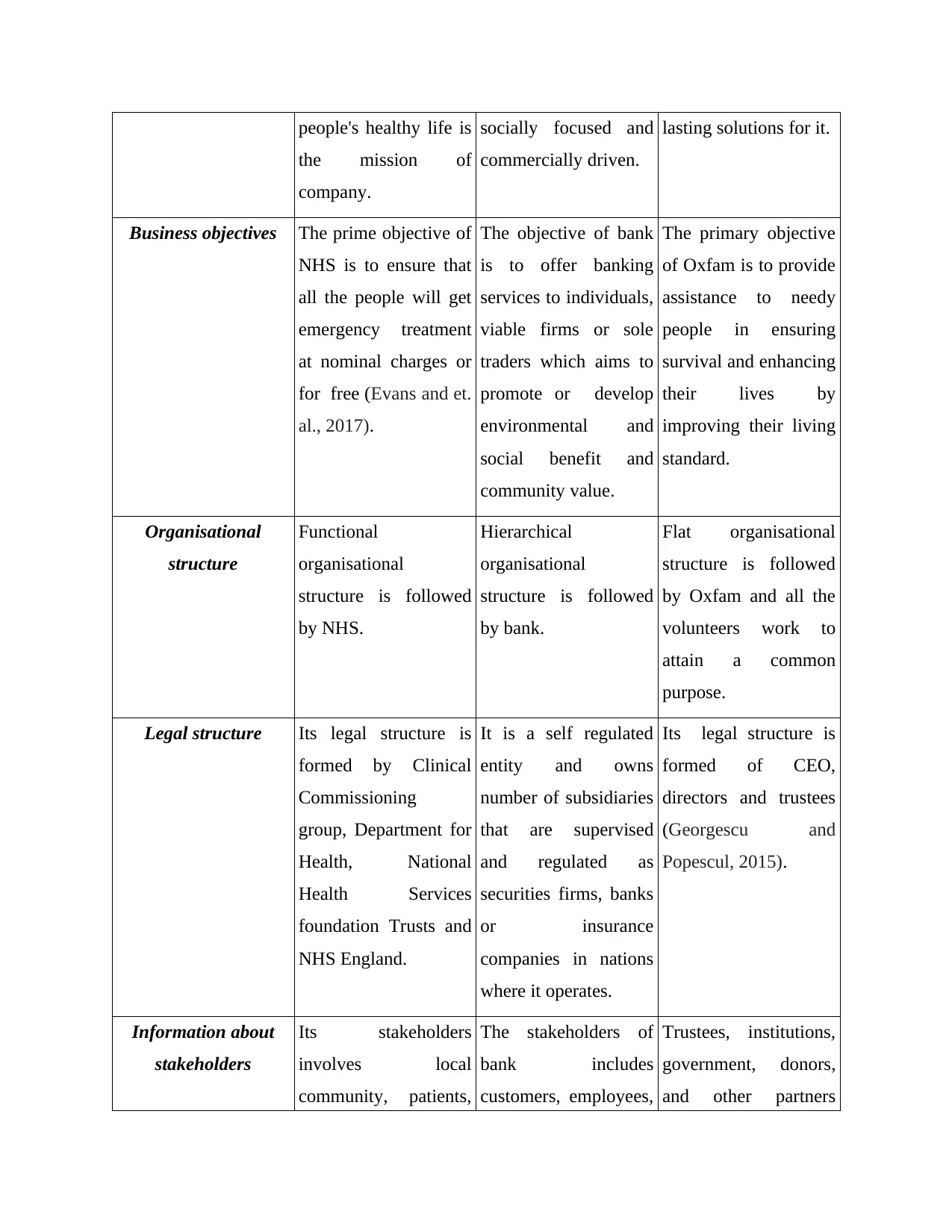
people's healthy life is
the mission of
company.
socially focused and
commercially driven.
lasting solutions for it.
Business objectives The prime objective of
NHS is to ensure that
all the people will get
emergency treatment
at nominal charges or
for free (Evans and et.
al., 2017).
The objective of bank
is to offer banking
services to individuals,
viable firms or sole
traders which aims to
promote or develop
environmental and
social benefit and
community value.
The primary objective
of Oxfam is to provide
assistance to needy
people in ensuring
survival and enhancing
their lives by
improving their living
standard.
Organisational
structure
Functional
organisational
structure is followed
by NHS.
Hierarchical
organisational
structure is followed
by bank.
Flat organisational
structure is followed
by Oxfam and all the
volunteers work to
attain a common
purpose.
Legal structure Its legal structure is
formed by Clinical
Commissioning
group, Department for
Health, National
Health Services
foundation Trusts and
NHS England.
It is a self regulated
entity and owns
number of subsidiaries
that are supervised
and regulated as
securities firms, banks
or insurance
companies in nations
where it operates.
Its legal structure is
formed of CEO,
directors and trustees
(Georgescu and
Popescul, 2015).
Information about
stakeholders
Its stakeholders
involves local
community, patients,
The stakeholders of
bank includes
customers, employees,
Trustees, institutions,
government, donors,
and other partners
the mission of
company.
socially focused and
commercially driven.
lasting solutions for it.
Business objectives The prime objective of
NHS is to ensure that
all the people will get
emergency treatment
at nominal charges or
for free (Evans and et.
al., 2017).
The objective of bank
is to offer banking
services to individuals,
viable firms or sole
traders which aims to
promote or develop
environmental and
social benefit and
community value.
The primary objective
of Oxfam is to provide
assistance to needy
people in ensuring
survival and enhancing
their lives by
improving their living
standard.
Organisational
structure
Functional
organisational
structure is followed
by NHS.
Hierarchical
organisational
structure is followed
by bank.
Flat organisational
structure is followed
by Oxfam and all the
volunteers work to
attain a common
purpose.
Legal structure Its legal structure is
formed by Clinical
Commissioning
group, Department for
Health, National
Health Services
foundation Trusts and
NHS England.
It is a self regulated
entity and owns
number of subsidiaries
that are supervised
and regulated as
securities firms, banks
or insurance
companies in nations
where it operates.
Its legal structure is
formed of CEO,
directors and trustees
(Georgescu and
Popescul, 2015).
Information about
stakeholders
Its stakeholders
involves local
community, patients,
The stakeholders of
bank includes
customers, employees,
Trustees, institutions,
government, donors,
and other partners
Paraphrase This Document
Need a fresh take? Get an instant paraphrase of this document with our AI Paraphraser
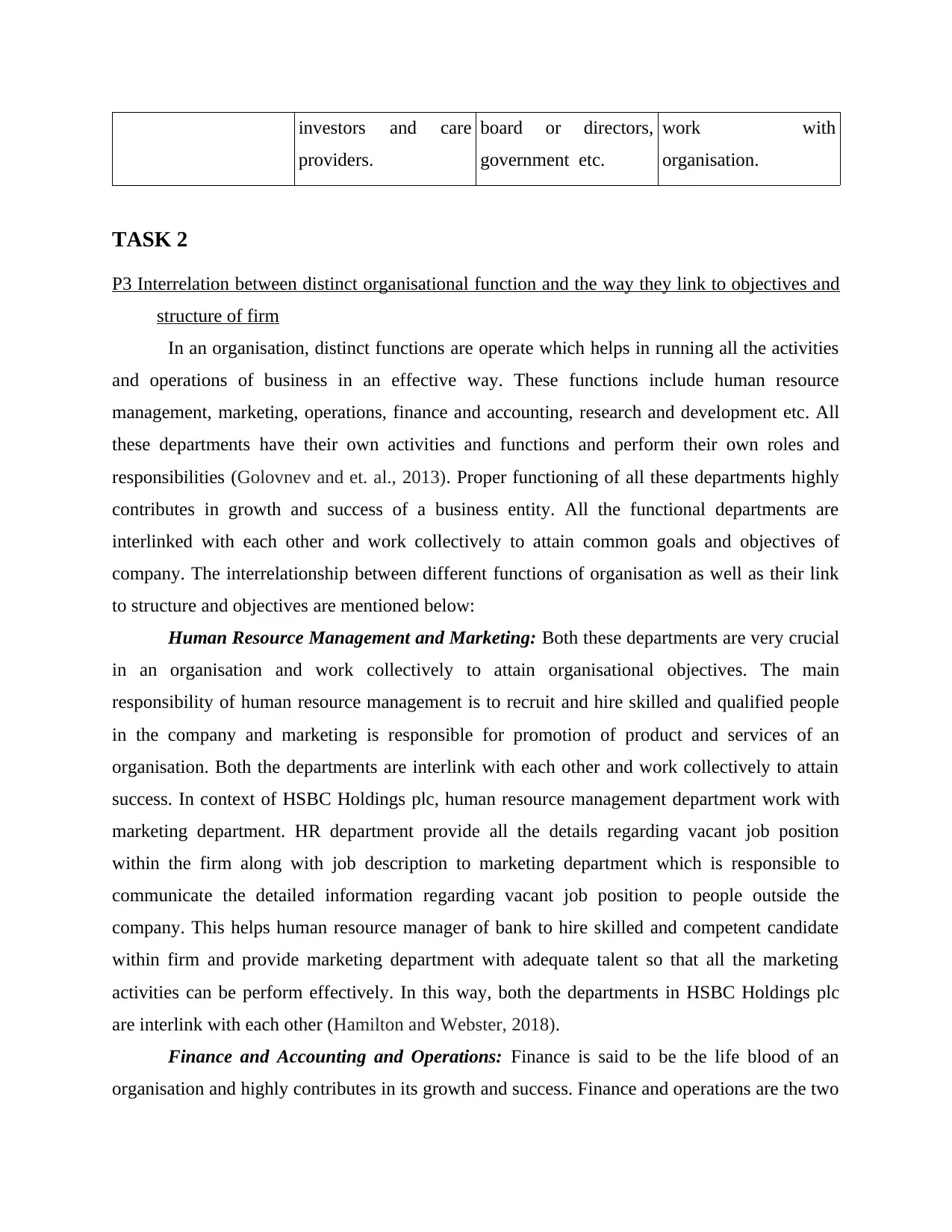
investors and care
providers.
board or directors,
government etc.
work with
organisation.
TASK 2
P3 Interrelation between distinct organisational function and the way they link to objectives and
structure of firm
In an organisation, distinct functions are operate which helps in running all the activities
and operations of business in an effective way. These functions include human resource
management, marketing, operations, finance and accounting, research and development etc. All
these departments have their own activities and functions and perform their own roles and
responsibilities (Golovnev and et. al., 2013). Proper functioning of all these departments highly
contributes in growth and success of a business entity. All the functional departments are
interlinked with each other and work collectively to attain common goals and objectives of
company. The interrelationship between different functions of organisation as well as their link
to structure and objectives are mentioned below:
Human Resource Management and Marketing: Both these departments are very crucial
in an organisation and work collectively to attain organisational objectives. The main
responsibility of human resource management is to recruit and hire skilled and qualified people
in the company and marketing is responsible for promotion of product and services of an
organisation. Both the departments are interlink with each other and work collectively to attain
success. In context of HSBC Holdings plc, human resource management department work with
marketing department. HR department provide all the details regarding vacant job position
within the firm along with job description to marketing department which is responsible to
communicate the detailed information regarding vacant job position to people outside the
company. This helps human resource manager of bank to hire skilled and competent candidate
within firm and provide marketing department with adequate talent so that all the marketing
activities can be perform effectively. In this way, both the departments in HSBC Holdings plc
are interlink with each other (Hamilton and Webster, 2018).
Finance and Accounting and Operations: Finance is said to be the life blood of an
organisation and highly contributes in its growth and success. Finance and operations are the two
providers.
board or directors,
government etc.
work with
organisation.
TASK 2
P3 Interrelation between distinct organisational function and the way they link to objectives and
structure of firm
In an organisation, distinct functions are operate which helps in running all the activities
and operations of business in an effective way. These functions include human resource
management, marketing, operations, finance and accounting, research and development etc. All
these departments have their own activities and functions and perform their own roles and
responsibilities (Golovnev and et. al., 2013). Proper functioning of all these departments highly
contributes in growth and success of a business entity. All the functional departments are
interlinked with each other and work collectively to attain common goals and objectives of
company. The interrelationship between different functions of organisation as well as their link
to structure and objectives are mentioned below:
Human Resource Management and Marketing: Both these departments are very crucial
in an organisation and work collectively to attain organisational objectives. The main
responsibility of human resource management is to recruit and hire skilled and qualified people
in the company and marketing is responsible for promotion of product and services of an
organisation. Both the departments are interlink with each other and work collectively to attain
success. In context of HSBC Holdings plc, human resource management department work with
marketing department. HR department provide all the details regarding vacant job position
within the firm along with job description to marketing department which is responsible to
communicate the detailed information regarding vacant job position to people outside the
company. This helps human resource manager of bank to hire skilled and competent candidate
within firm and provide marketing department with adequate talent so that all the marketing
activities can be perform effectively. In this way, both the departments in HSBC Holdings plc
are interlink with each other (Hamilton and Webster, 2018).
Finance and Accounting and Operations: Finance is said to be the life blood of an
organisation and highly contributes in its growth and success. Finance and operations are the two
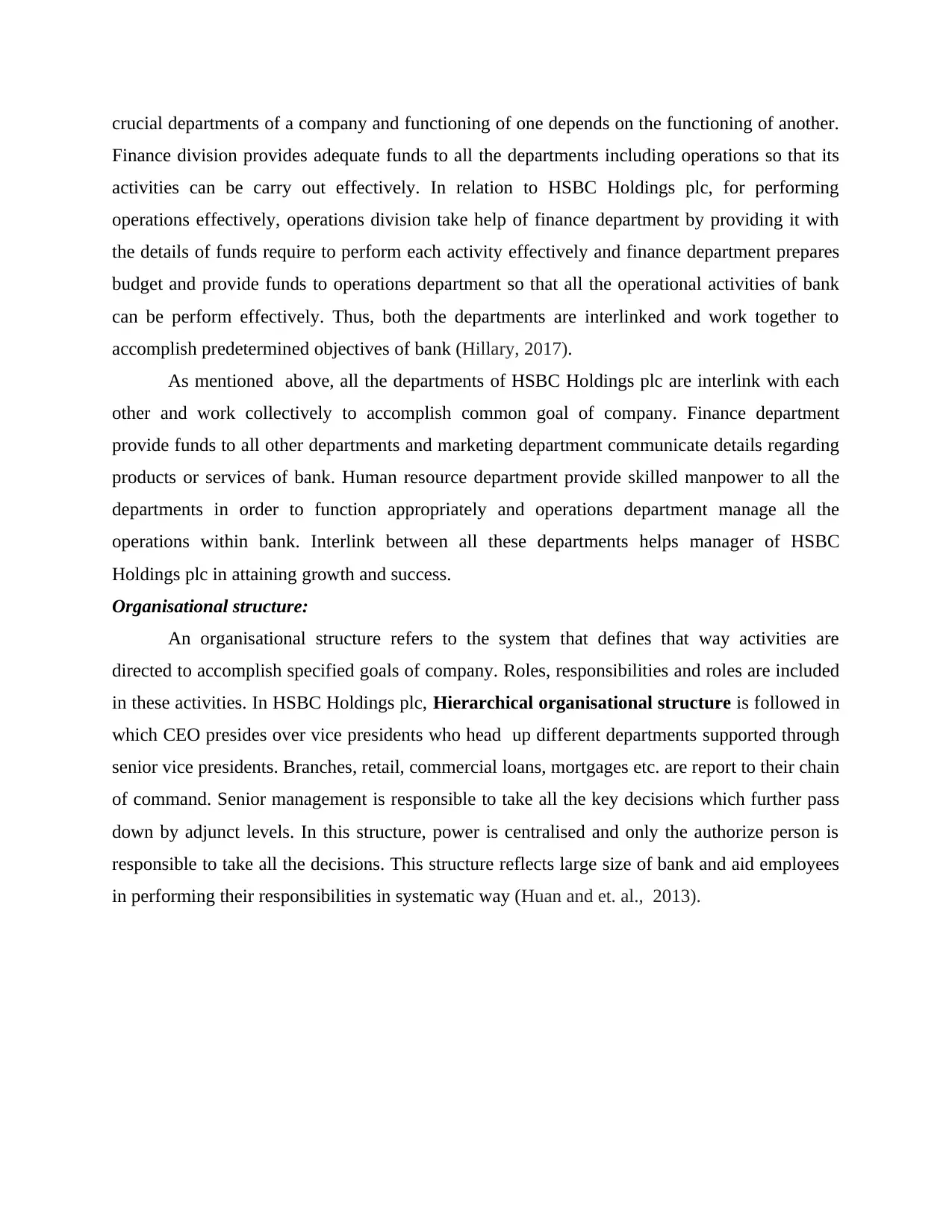
crucial departments of a company and functioning of one depends on the functioning of another.
Finance division provides adequate funds to all the departments including operations so that its
activities can be carry out effectively. In relation to HSBC Holdings plc, for performing
operations effectively, operations division take help of finance department by providing it with
the details of funds require to perform each activity effectively and finance department prepares
budget and provide funds to operations department so that all the operational activities of bank
can be perform effectively. Thus, both the departments are interlinked and work together to
accomplish predetermined objectives of bank (Hillary, 2017).
As mentioned above, all the departments of HSBC Holdings plc are interlink with each
other and work collectively to accomplish common goal of company. Finance department
provide funds to all other departments and marketing department communicate details regarding
products or services of bank. Human resource department provide skilled manpower to all the
departments in order to function appropriately and operations department manage all the
operations within bank. Interlink between all these departments helps manager of HSBC
Holdings plc in attaining growth and success.
Organisational structure:
An organisational structure refers to the system that defines that way activities are
directed to accomplish specified goals of company. Roles, responsibilities and roles are included
in these activities. In HSBC Holdings plc, Hierarchical organisational structure is followed in
which CEO presides over vice presidents who head up different departments supported through
senior vice presidents. Branches, retail, commercial loans, mortgages etc. are report to their chain
of command. Senior management is responsible to take all the key decisions which further pass
down by adjunct levels. In this structure, power is centralised and only the authorize person is
responsible to take all the decisions. This structure reflects large size of bank and aid employees
in performing their responsibilities in systematic way (Huan and et. al., 2013).
Finance division provides adequate funds to all the departments including operations so that its
activities can be carry out effectively. In relation to HSBC Holdings plc, for performing
operations effectively, operations division take help of finance department by providing it with
the details of funds require to perform each activity effectively and finance department prepares
budget and provide funds to operations department so that all the operational activities of bank
can be perform effectively. Thus, both the departments are interlinked and work together to
accomplish predetermined objectives of bank (Hillary, 2017).
As mentioned above, all the departments of HSBC Holdings plc are interlink with each
other and work collectively to accomplish common goal of company. Finance department
provide funds to all other departments and marketing department communicate details regarding
products or services of bank. Human resource department provide skilled manpower to all the
departments in order to function appropriately and operations department manage all the
operations within bank. Interlink between all these departments helps manager of HSBC
Holdings plc in attaining growth and success.
Organisational structure:
An organisational structure refers to the system that defines that way activities are
directed to accomplish specified goals of company. Roles, responsibilities and roles are included
in these activities. In HSBC Holdings plc, Hierarchical organisational structure is followed in
which CEO presides over vice presidents who head up different departments supported through
senior vice presidents. Branches, retail, commercial loans, mortgages etc. are report to their chain
of command. Senior management is responsible to take all the key decisions which further pass
down by adjunct levels. In this structure, power is centralised and only the authorize person is
responsible to take all the decisions. This structure reflects large size of bank and aid employees
in performing their responsibilities in systematic way (Huan and et. al., 2013).
⊘ This is a preview!⊘
Do you want full access?
Subscribe today to unlock all pages.

Trusted by 1+ million students worldwide
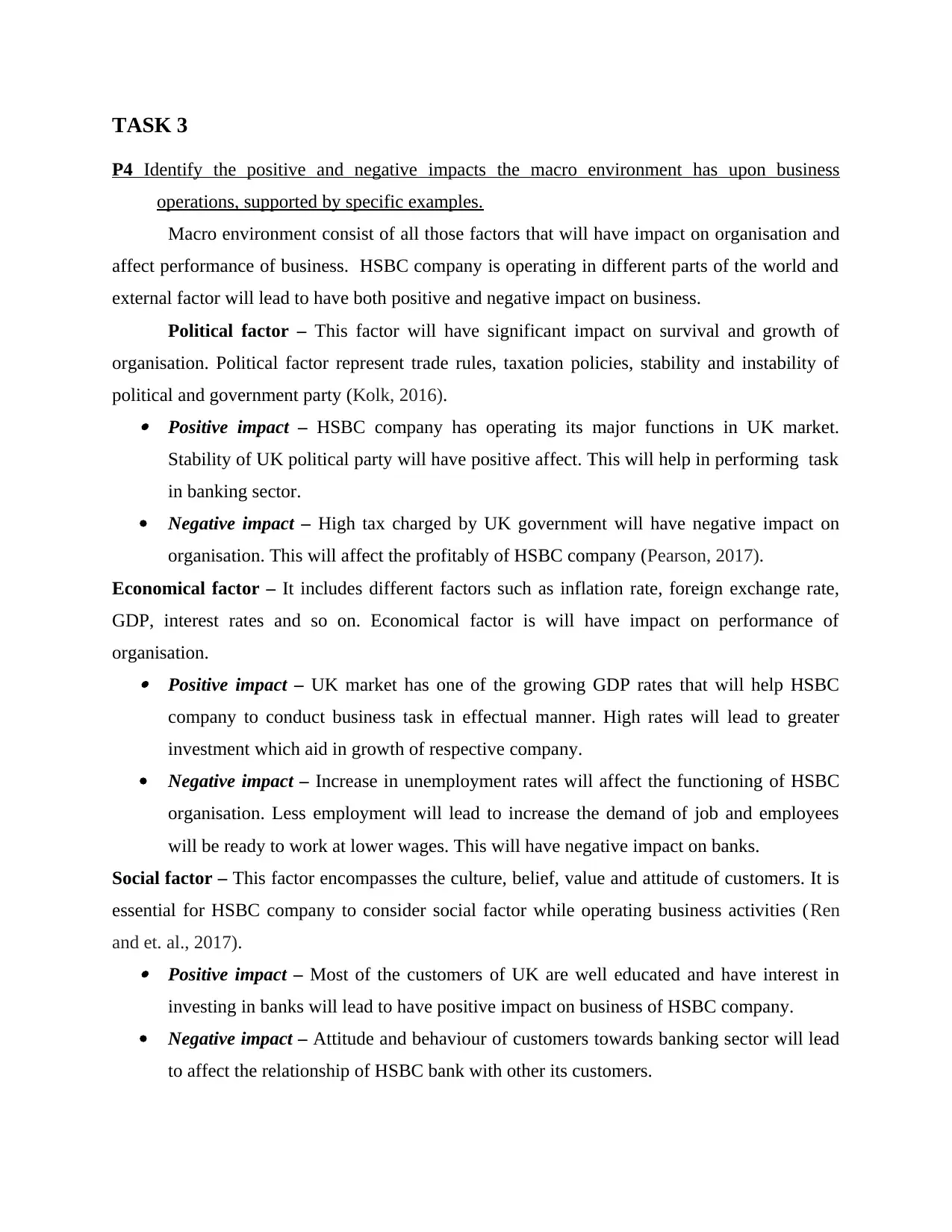
TASK 3
P4 Identify the positive and negative impacts the macro environment has upon business
operations, supported by specific examples.
Macro environment consist of all those factors that will have impact on organisation and
affect performance of business. HSBC company is operating in different parts of the world and
external factor will lead to have both positive and negative impact on business.
Political factor – This factor will have significant impact on survival and growth of
organisation. Political factor represent trade rules, taxation policies, stability and instability of
political and government party (Kolk, 2016). Positive impact – HSBC company has operating its major functions in UK market.
Stability of UK political party will have positive affect. This will help in performing task
in banking sector.
Negative impact – High tax charged by UK government will have negative impact on
organisation. This will affect the profitably of HSBC company (Pearson, 2017).
Economical factor – It includes different factors such as inflation rate, foreign exchange rate,
GDP, interest rates and so on. Economical factor is will have impact on performance of
organisation. Positive impact – UK market has one of the growing GDP rates that will help HSBC
company to conduct business task in effectual manner. High rates will lead to greater
investment which aid in growth of respective company.
Negative impact – Increase in unemployment rates will affect the functioning of HSBC
organisation. Less employment will lead to increase the demand of job and employees
will be ready to work at lower wages. This will have negative impact on banks.
Social factor – This factor encompasses the culture, belief, value and attitude of customers. It is
essential for HSBC company to consider social factor while operating business activities (Ren
and et. al., 2017). Positive impact – Most of the customers of UK are well educated and have interest in
investing in banks will lead to have positive impact on business of HSBC company.
Negative impact – Attitude and behaviour of customers towards banking sector will lead
to affect the relationship of HSBC bank with other its customers.
P4 Identify the positive and negative impacts the macro environment has upon business
operations, supported by specific examples.
Macro environment consist of all those factors that will have impact on organisation and
affect performance of business. HSBC company is operating in different parts of the world and
external factor will lead to have both positive and negative impact on business.
Political factor – This factor will have significant impact on survival and growth of
organisation. Political factor represent trade rules, taxation policies, stability and instability of
political and government party (Kolk, 2016). Positive impact – HSBC company has operating its major functions in UK market.
Stability of UK political party will have positive affect. This will help in performing task
in banking sector.
Negative impact – High tax charged by UK government will have negative impact on
organisation. This will affect the profitably of HSBC company (Pearson, 2017).
Economical factor – It includes different factors such as inflation rate, foreign exchange rate,
GDP, interest rates and so on. Economical factor is will have impact on performance of
organisation. Positive impact – UK market has one of the growing GDP rates that will help HSBC
company to conduct business task in effectual manner. High rates will lead to greater
investment which aid in growth of respective company.
Negative impact – Increase in unemployment rates will affect the functioning of HSBC
organisation. Less employment will lead to increase the demand of job and employees
will be ready to work at lower wages. This will have negative impact on banks.
Social factor – This factor encompasses the culture, belief, value and attitude of customers. It is
essential for HSBC company to consider social factor while operating business activities (Ren
and et. al., 2017). Positive impact – Most of the customers of UK are well educated and have interest in
investing in banks will lead to have positive impact on business of HSBC company.
Negative impact – Attitude and behaviour of customers towards banking sector will lead
to affect the relationship of HSBC bank with other its customers.
Paraphrase This Document
Need a fresh take? Get an instant paraphrase of this document with our AI Paraphraser
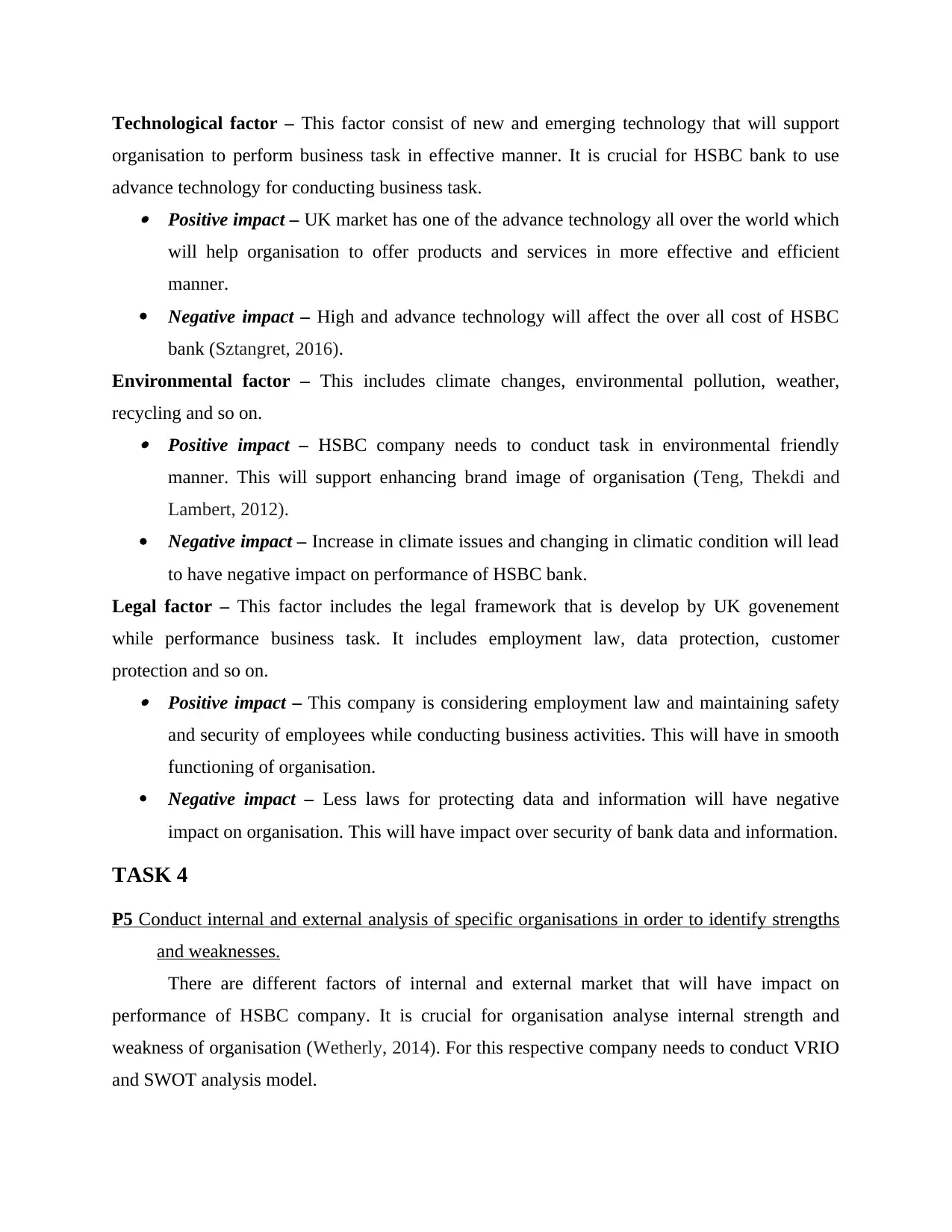
Technological factor – This factor consist of new and emerging technology that will support
organisation to perform business task in effective manner. It is crucial for HSBC bank to use
advance technology for conducting business task. Positive impact – UK market has one of the advance technology all over the world which
will help organisation to offer products and services in more effective and efficient
manner.
Negative impact – High and advance technology will affect the over all cost of HSBC
bank (Sztangret, 2016).
Environmental factor – This includes climate changes, environmental pollution, weather,
recycling and so on. Positive impact – HSBC company needs to conduct task in environmental friendly
manner. This will support enhancing brand image of organisation (Teng, Thekdi and
Lambert, 2012).
Negative impact – Increase in climate issues and changing in climatic condition will lead
to have negative impact on performance of HSBC bank.
Legal factor – This factor includes the legal framework that is develop by UK govenement
while performance business task. It includes employment law, data protection, customer
protection and so on. Positive impact – This company is considering employment law and maintaining safety
and security of employees while conducting business activities. This will have in smooth
functioning of organisation.
Negative impact – Less laws for protecting data and information will have negative
impact on organisation. This will have impact over security of bank data and information.
TASK 4
P5 Conduct internal and external analysis of specific organisations in order to identify strengths
and weaknesses.
There are different factors of internal and external market that will have impact on
performance of HSBC company. It is crucial for organisation analyse internal strength and
weakness of organisation (Wetherly, 2014). For this respective company needs to conduct VRIO
and SWOT analysis model.
organisation to perform business task in effective manner. It is crucial for HSBC bank to use
advance technology for conducting business task. Positive impact – UK market has one of the advance technology all over the world which
will help organisation to offer products and services in more effective and efficient
manner.
Negative impact – High and advance technology will affect the over all cost of HSBC
bank (Sztangret, 2016).
Environmental factor – This includes climate changes, environmental pollution, weather,
recycling and so on. Positive impact – HSBC company needs to conduct task in environmental friendly
manner. This will support enhancing brand image of organisation (Teng, Thekdi and
Lambert, 2012).
Negative impact – Increase in climate issues and changing in climatic condition will lead
to have negative impact on performance of HSBC bank.
Legal factor – This factor includes the legal framework that is develop by UK govenement
while performance business task. It includes employment law, data protection, customer
protection and so on. Positive impact – This company is considering employment law and maintaining safety
and security of employees while conducting business activities. This will have in smooth
functioning of organisation.
Negative impact – Less laws for protecting data and information will have negative
impact on organisation. This will have impact over security of bank data and information.
TASK 4
P5 Conduct internal and external analysis of specific organisations in order to identify strengths
and weaknesses.
There are different factors of internal and external market that will have impact on
performance of HSBC company. It is crucial for organisation analyse internal strength and
weakness of organisation (Wetherly, 2014). For this respective company needs to conduct VRIO
and SWOT analysis model.
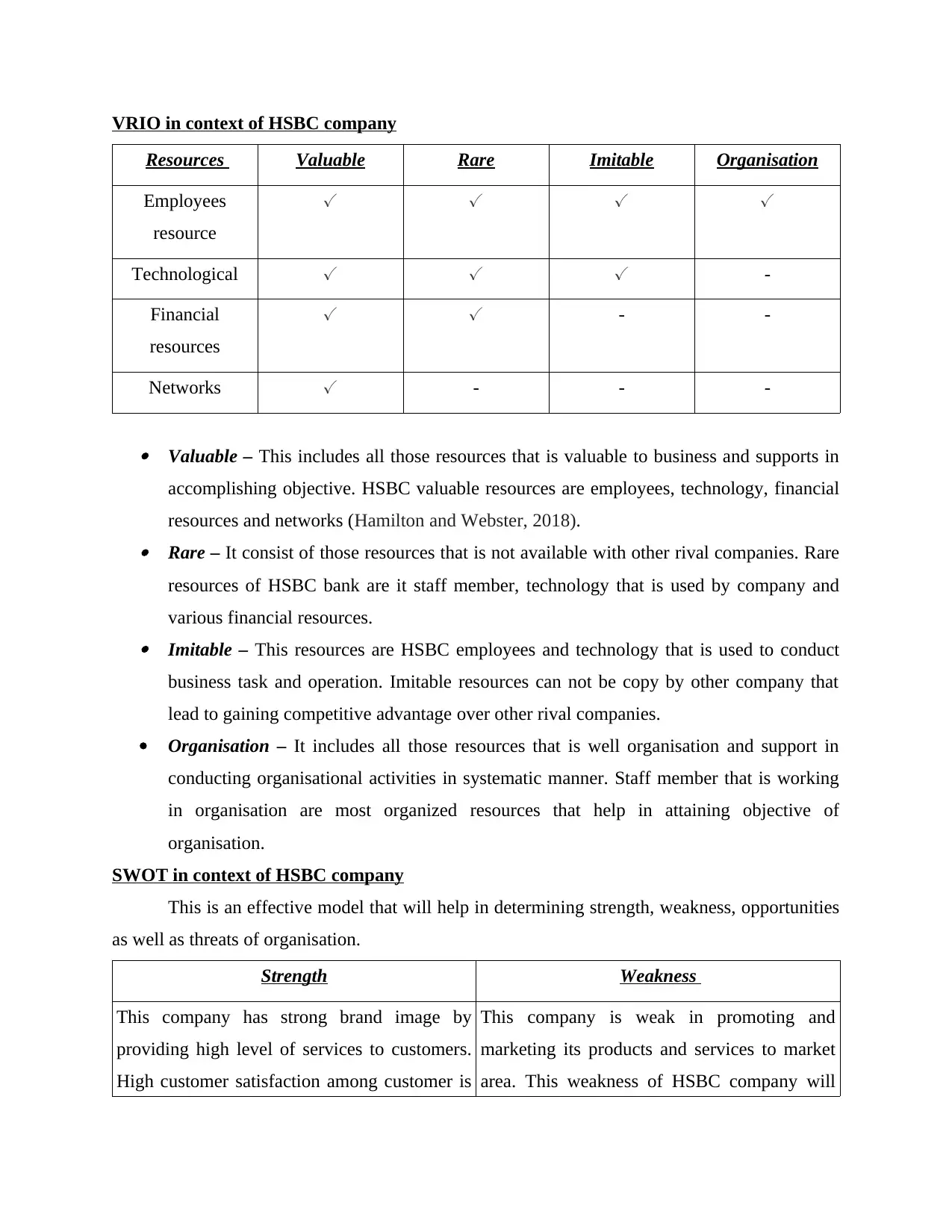
VRIO in context of HSBC company
Resources Valuable Rare Imitable Organisation
Employees
resource
✓ ✓ ✓ ✓
Technological ✓ ✓ ✓ -
Financial
resources
✓ ✓ - -
Networks ✓ - - -
Valuable – This includes all those resources that is valuable to business and supports in
accomplishing objective. HSBC valuable resources are employees, technology, financial
resources and networks (Hamilton and Webster, 2018). Rare – It consist of those resources that is not available with other rival companies. Rare
resources of HSBC bank are it staff member, technology that is used by company and
various financial resources. Imitable – This resources are HSBC employees and technology that is used to conduct
business task and operation. Imitable resources can not be copy by other company that
lead to gaining competitive advantage over other rival companies.
Organisation – It includes all those resources that is well organisation and support in
conducting organisational activities in systematic manner. Staff member that is working
in organisation are most organized resources that help in attaining objective of
organisation.
SWOT in context of HSBC company
This is an effective model that will help in determining strength, weakness, opportunities
as well as threats of organisation.
Strength Weakness
This company has strong brand image by
providing high level of services to customers.
High customer satisfaction among customer is
This company is weak in promoting and
marketing its products and services to market
area. This weakness of HSBC company will
Resources Valuable Rare Imitable Organisation
Employees
resource
✓ ✓ ✓ ✓
Technological ✓ ✓ ✓ -
Financial
resources
✓ ✓ - -
Networks ✓ - - -
Valuable – This includes all those resources that is valuable to business and supports in
accomplishing objective. HSBC valuable resources are employees, technology, financial
resources and networks (Hamilton and Webster, 2018). Rare – It consist of those resources that is not available with other rival companies. Rare
resources of HSBC bank are it staff member, technology that is used by company and
various financial resources. Imitable – This resources are HSBC employees and technology that is used to conduct
business task and operation. Imitable resources can not be copy by other company that
lead to gaining competitive advantage over other rival companies.
Organisation – It includes all those resources that is well organisation and support in
conducting organisational activities in systematic manner. Staff member that is working
in organisation are most organized resources that help in attaining objective of
organisation.
SWOT in context of HSBC company
This is an effective model that will help in determining strength, weakness, opportunities
as well as threats of organisation.
Strength Weakness
This company has strong brand image by
providing high level of services to customers.
High customer satisfaction among customer is
This company is weak in promoting and
marketing its products and services to market
area. This weakness of HSBC company will
⊘ This is a preview!⊘
Do you want full access?
Subscribe today to unlock all pages.

Trusted by 1+ million students worldwide
1 out of 17
Related Documents
Your All-in-One AI-Powered Toolkit for Academic Success.
+13062052269
info@desklib.com
Available 24*7 on WhatsApp / Email
![[object Object]](/_next/static/media/star-bottom.7253800d.svg)
Unlock your academic potential
Copyright © 2020–2025 A2Z Services. All Rights Reserved. Developed and managed by ZUCOL.





